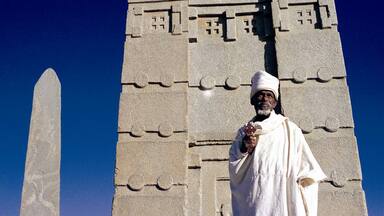Major archaeological discoveries in Aksum
Major archaeological vestiges have been discovered at the World Heritage site of Aksum (Ethiopia) by the experts UNESCO sent to Aksum (Ethiopia) to survey the World Heritage Site last week. They were sent to prepare for the elevation of the Aksum Obelisk at its original location. The last segment of the 160-tonne 24.6-metre high stele arrived at the airport of Aksum this morning. It had been in Rome since 1937.
“Underground chambers and arcades have been found in the vicinity of the original location of the obelisk,” declared Elizabeth Wangari of UNESCO’s World Heritage Centre and Jim Williams, of the Organization’s Culture Sector, who took part in the mission. “Geo-radar and electrotomographic prospection – the most advanced technologies for underground observation – revealed the existence of several vast funerary chambers under the site’s parking ground which was built in 1963.”
According to the experts, the site is a royal necropolis used by several dynasties before the Christian era. It stretches considerably beyond the perimeter of the present archaeological site, at the foot of Mount Saint George and Mount Mariam.
The team of UNESCO experts, headed by archaeologist Rodolfo Fattovich, an expert on Aksum at the Instituto Universitario Orientale of Naples (Italy) conducted a “non-invasive archaeological prospection” of the site. The data collected through geo-radar and electrotomographic prospection are being processed at a laboratory of La Sapienza University in Rome and will be used to create 3D models of the royal tombs. The processed data will be communicated to the governments of Ethiopia and Italy.
A number of tombs, some of them pillaged, have been discovered in Aksum since the 1970s. Their riches are at the archaeological museums of Aksum and Addis Ababa. Only one of the Aksum tombs, the Tomb of the False Door, is open to the public.
The Director-General of UNESCO, Koïchiro Matsuura, welcomed this important discovery. “It is likely that some of the tombs identified through under-ground imaging are intact,” he said. “Archaeological excavations would now be required to uncover possible vestiges of major historical interest. The opening of these new tombs to the public would represent, moreover, an additional asset for the site, which, by boosting cultural tourism, would contribute to the economic development of the country”.
The archaeological site of Aksum consists of three parts and contains 176 stelae: the Northern Site, the Gudit Stelae Field (named after the Jewish Queen who took power in the 10th century) and the central area where the stele, now known as the Aksum Obelisk, used to stand. Its foundations form a 6-metre 10m2 hole. According to experts, pillagers caused the obelisk to topple over in either the 10th or 16th centuries.
The Central Field is also the site of the largest monolith ever sculpted (33 metres), which probably collapsed immediately after its erection in the 3rd or 4th century, destroying the Nafas Machau temple whose ruins are nearby.
Aksum was inscribed on the World Heritage List in 1980. Last November the governments of Ethiopia and Italy signed a bilateral agreement on the return of the Aksum Obelisk, within the framework of UNESCO’s 1972 Convention Concerning the Protection of the World Cultural and Natural Heritage. By virtue of the Convention, they asked for UNESCO’s cooperation. The Convention commits states parties “to give their help in the identification, protection, conservation and presentation of the cultural and natural heritage.”
The UNESCO World Heritage expert mission and its follow-up are being undertaken in close co-operation with the Permanent Delegation to UNESCO, the national authorities in Addis Ababa and the UNESCO office in Addis Ababa.



